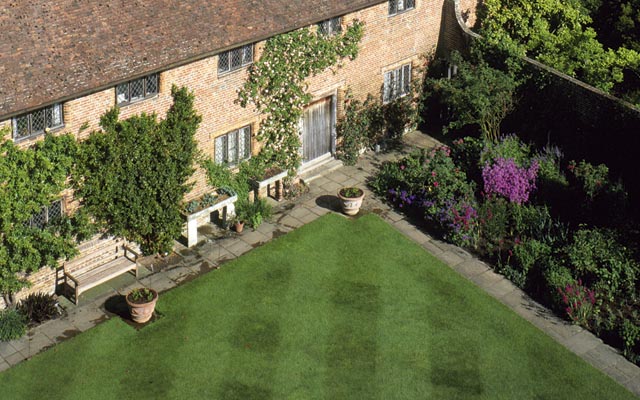Caring for your lawn this autumn
Country Life details the best way to preserve your lawn this autumn.


A view from The Tower at Sissinghurst, showing the house and library in the foreground, with the Oasts, Barn and Granary beyond.
Given our desire to return Sissinghurst to a more relaxed, romantic place, where the distinctive qualities of Vita and Harold’s garden are emphasised over and above maintenance and technique, it was very interesting to discover that Vita had written in The Observer, in 1954, about her use of selective weedkillers at Sissinghurst:‘Instead of crawling about on all fours in solitary bad temper and incipient lumbago with a trowel or a broken kitchen knife, you may now promenade in a leisurely way, sauntering up and down, sprinkling selective death from a watering can as you converse with friends who have come to tea.’ Banished forever is the myth that Vita loved daisies in the lawn; I even have to question an old friend of mine who tells me that, as a girl, she used to come to Sissinghurst and make daisy chains with Vita.
Daisies or no daisies, effective lawn management at Sissinghurst is even more important now, with up to 200,000 pairs of feet treading on the tiny grass plants that make up the lawns. It’s due to intensive autumn maintenance that the lawns don’t just survive, but thrive.
Scarify and spike One of the most important things we do in the autumn is to remove the dead grass or ‘thatch’ that lies in the sward. We do it by scratching the grass very hard with a mechanical rake; this allows air, light and moisture into the new shoots and roots and discourages diseases or weak growth. To make the job easier, we mow the grass first, using a rotary mower.
Once the thatch is removed to the compost heap (added in layers with alternate dressings of lime and sulphate of ammonia to aid decomposition), we pass over the area again with the rotary mower, which acts like a vacuum, sucking up any remaining loose thatch. The lawn is then allowed to rest while the weather is still warm enough for the production of new roots and shoots.
The next task is to improve surface aeration and drainage; throughout the season, we use a mechanical spiker with solid tines to create slots to a depth of 6cm (about 2½in). But, following scarifying in the autumn, we switch to spiking with hollow tines that remove cores of soil; the holes are then filled by brushing in a top dressing of sharp sand and loam.
Most of the lawns at Sissinghurst were created out of rough meadow grass in the 1930s. However, for a lawn to be resilient to wear, drought-resistant and tolerant of close mowing, one needs a high percentage of dwarf ryegrass in the sward. Following scarifying and spiking, we rake top dressing into the surface and thinly sow a blend of dwarf ryegrasses, smooth-stalked meadow grass, browntop bent and Chewing’s fescue. This has strengthened the lawns and made them more able to absorb wear and tear.
Sometimes, a particular plant or association is so popular with visitors that it can cause an area of lawn to become threadbare; Pam Schwerdt (Joint Head Gardener from 1959 to 1990) named them ‘admiration patches’. To repair them, we grow plugs of grass in cell trays throughout the year. The plugs can then be inserted into bare areas without the need for major work or closing the area.
Exquisite houses, the beauty of Nature, and how to get the most from your life, straight to your inbox.
Follow-up feeding A high level of foot traffic on the lawns at Sissinghurst makes it impossible to apply standard turf fertilisers in the open season without causing damage. The solution is to use a controlled-release fertiliser, which adjusts its output according to temperature and water availability, providing a constant growth through the season.
In autumn, we apply a fertiliser high in potash, to encourage strong root growth and, in spring, we use a fertiliser high in nitrogen to encourage grass growth. During the summer, I may also use a top-up of liquid seaweed if early signs of stress begin to show.
Country Life is unlike any other magazine: the only glossy weekly on the newsstand and the only magazine that has been guest-edited by His Majesty The King not once, but twice. It is a celebration of modern rural life and all its diverse joys and pleasures — that was first published in Queen Victoria's Diamond Jubilee year. Our eclectic mixture of witty and informative content — from the most up-to-date property news and commentary and a coveted glimpse inside some of the UK's best houses and gardens, to gardening, the arts and interior design, written by experts in their field — still cannot be found in print or online, anywhere else.
